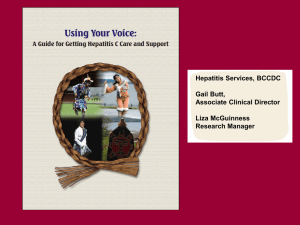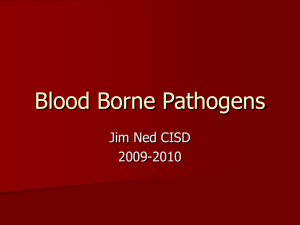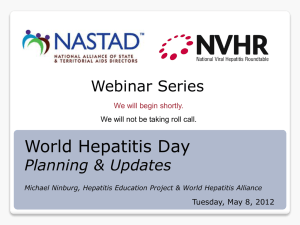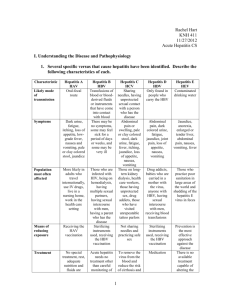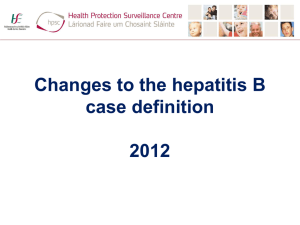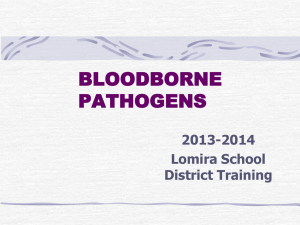File - Medical Nutrition Therapy Portfolio
advertisement
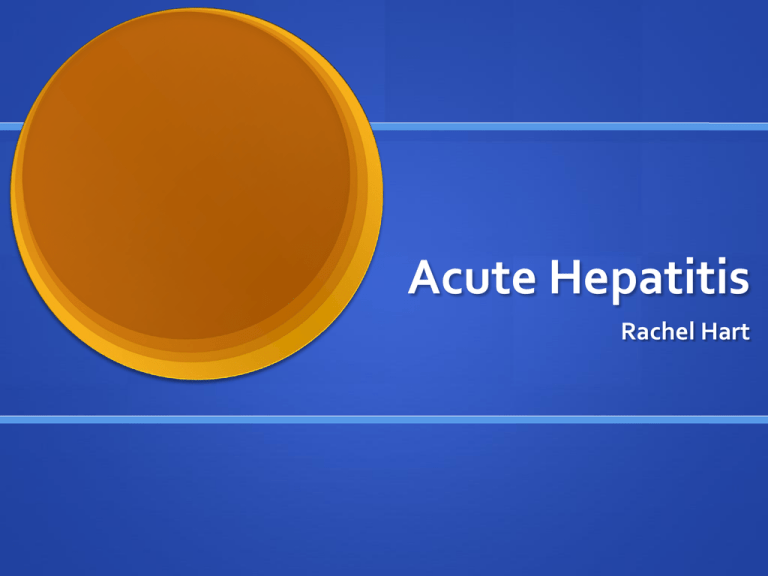
Acute Hepatitis Rachel Hart Client Background Teresa (Terri) Wilcox 22-year-old female Education: Full time college graduate student during the day Hours of work: An exotic dancer in the evenings to early morning Ethnic back ground: European American Religious affiliation: Unitarian Anthropometric Data Height: 5 feet 9 inches Current weight: 130 pounds Usual body weight: 145 pounds Percent usual body weight: 90% Moderate to severe malnutrition BMI: 19.2 kg/m2 Just within normal weight range Patient History Relatively good health all her life, does have seasonal allergies, non smoker, non drug user, does drink 1-2 glasses of wine per week Family history: hypertension, diverticulitis, cholecystitis, diabetes, peptic ulcer disease, bilateral breast cancer, leukemia, cirrhosis, amyotrophic lateral sclerosis Medications: YAZ, 1 tab po daily Allegra, 60 mg po qd Complains of fatigue, aches, and pains, vague right upper quadrant pain, and nausea and anorexia Primary Complaint “I just feel so tired. I can hardly move, my joints ache so much, and my muscles feel sore.” Physical Exam General appearance: Tired-looking, college-aged female Eyes: Wears contact lenses to correct myopia, PERRLA Extremities: Normal muscle tone, normal ROM Abdomen: Pierced umbilicus; upper right abdomen guarding Nutrition History General: Appetite usually good, but has not had one in the last few weeks 24 –hour recall showed that she had not consumed adequate nutrition Usual dietary intake: Breakfast: Usually cereal and orange juice Lunch: Takes lunch to eat on campus or gets fast food at the Student Union Dinner: Eats at work, usually carryout (Chinese food) Vitamin and mineral intake: 400 mg vitamin E qd 500 mg calcium multivitamin/ mineral qd Abnormal Chemistry Bilirubin Normal: ≤ 0.3 mg/dL Terri: 1.5 mg/dL (high) ALT (alanine aminotransferase) Normal: 4-36 U/L Terri: 340 U/L (high) AST (aspartate aminotransferase) Normal: 0-35 U/L Terri: 500 U/L (high) ALP (alkaline phosphatase) Normal: 30-120 U/L Terri: 303 U/L (high) LDH (lactate dehydrogenase) Normal: 208-378 U/L Terri: 695 U/L (high) HDL-C Normal: >50 mg/dL Terri: 50 mg/dL (low) Abnormal Hematology WBC (white blood cell) Normal: 4.8-11.8 x 10^3/mm^3 Terri: 12.6 x 10^3/mm^3 (high) HGB (hemoglobin) Normal: 12-15 g/dL Terri: 11.5 g/dL (low) HCT (hematocrit) Normal: 37-47 % Terri: 36 % (low) Platelet count Normal: 140- 144 x 10^3/mm^3 Terri: 140 x 10^3/mm^3 (low) PT (prothrombin time) Normal: 11-16 sec Terri: 17 sec (high) Abnormal Urinalysis Protein Normal: NEG mg/dL Terri: 1+ mg/dL Diagnosis and Treatment Diagnosis Acute hepatitis C Treatment Vitamin B-complex supplement High-kcal, high-protein diet Bed rest Continued Allegra Alternative contraception What is Acute Hepatitis C? Means inflammation of the liver. Acute hepatitis C virus infection is a short-term illness that occurs within the first 6 months after someone is exposed to the hepatitis C virus. For most people, acute infection leads to chronic infection. Hepatitis A, B, C, D, E are diseases caused by five different viruses. Etiology People can become infected with the hepatitis C virus during such activities as: Sharing needles, syringes, or other equipment to inject drugs Needle stick injuries in health care settings Being born to a mother who has hepatitis Less commonly, a person can also get hepatitis C virus through: Sharing personal care items that may have come in contact with another person’s blood, such as razors or toothbrushes Having sexual contact with a person infected with the hepatitis C virus Symptoms Approximately 70%–80% of people with acute hepatitis C do not have any symptoms. Some people, however, can have mild to severe symptoms soon after being infected, including: Fever Fatigue Muscle aches Loss of appetite Nausea Vomiting Abdominal pain Dark urine Clay-colored bowel movements Joint pain Jaundice Diagnostic Measures Acute hepatitis is often tested for because of the appearance of symptoms Blood tests: Anti-HCV: Looks for and measures antibodies to HCV HCV RNA: Qualitative test: detects the presence or absence of HCV RNA Quantitative test: measures the number of copies of HCV RNA in the blood Diagnostic Measures Blood tests may help to: Determine whether a person has the hepatitis C virus Measure the quantity of the hepatitis C virus in the blood Evaluate the genetic makeup of the virus, which helps determine treatment options Treatment Primary medical treatments: Regenerate liver cells and prevent and delay formation of chronic hepatitis with drugs 3-MU interferon alfa-2b sq qd Ribavirin (Rebetol) 200 mg po bid Bed rest Medical nutrition therapy High calorie, high protein diet Micronutrient supplementation Medical Nutrition Therapy Doctors usually recommend rest, adequate nutrition and fluids. Want to avoid further damage of the liver and regenerate cells. Consult dietitian: Increased energy needs 30-35 kcal/kg body weight Adequate protein 1-1.2 g/kg body weight 30-40% of kilocalories from fat Multivitamin Abstain from alcohol Client Energy and Protein Needs Kilocalorie needs: 30-35 (kcal) x 65.9 (kg)= 1,977 to 2,307 kilocalories per kilogram of body weight per day Range of: 2,000-2,300 kilocalories per day Protein needs: 1-1.2 (grams) x 65.9 (kg)= 65.9-79.1 grams of protein per kilogram of body weight per day Range of: 66-79 grams per day Prognosis Out of every 100 people infected with the Hepatitis C virus: About 75–85 people will develop chronic Hepatitis C virus infection; of those, 60–70 people will go on to develop chronic liver disease 5–20 people will go on to develop cirrhosis over a period of 20–30 years 1–5 people will die from cirrhosis or liver cancer Questions?? References Hepatitis C. (2102). Lab Tests Online. Retrieved from http://labtestsonline.org/understanding/analytes/hepatitis-c/tab/test Hepatitis C. (2102). National Institutes of Health [NIH]. Retrieved from http://www.nlm.nih.gov/medlineplus/hepatitisc.html Hepatitis C information for the public. (2012). Center For Disease Control and Prevention. Retrieved from http://www.cdc.gov/hepatitis/c/index.htm Hepatitis C: Nutrition care. (2012). Dietitians of Canada. Retrieved from http://ww.bccdc.ca/NR/rdonlyres/EA6145BC-FF7B-448A-B5E66EDED47D878C/0/Hep_Guidelines_HCVNutritionCare.pdf Interferon and ribavirin treatment side effects. (2012). Department of Veteran Affairs. Retrieved from http://www.hepatitis.va.gov/provider/reviews/treatment-sideeffects.asp
